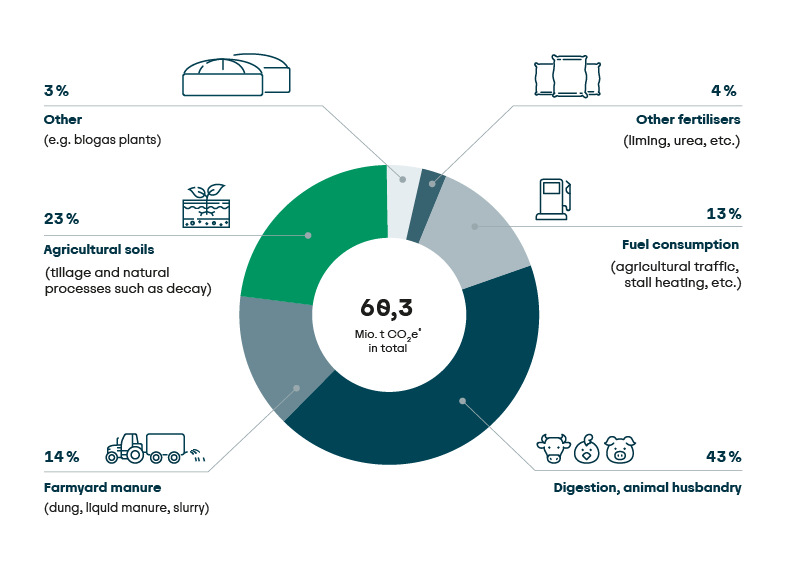Specific characteristics of emissions in the agriculture sector
According to the German Federal Environment Agency (Umweltbundesamt, UBA), agriculture caused about 60.3 million tons of CO2e in 2023. This represents about 8.9% of Germany’s total greenhouse gas emissions. An updated measurement for the year 2024 has not yet been published.
Emission sources in German agriculture (2023, in CO2 equivalents)
| 2023 | ||
| Digestion, animal husbandry | 25.8 | |
| Farmyard manure | 8.8 | |
| Agricultural soils | 13.7 | |
| Other manure | 2.3 | |
| Other | 1.6 | |
| Fuel consumption | 8.1 | |
| Total | 60.3 | |
| Table 1: Emission sources in German agriculture (absolute) | ||
Emission sources in German agriculture (2023, as a percentage of the sector’s total emissions)
Figure 2: Emission sources in German agriculture (relative), source: UBA 2023
Breakdown of greenhouse gases as a percentage of total emissions in agriculture (2023, in percent)
Figure 3: Breakdown of greenhouse gases as a percentage of total emissions in agriculture, source: UBA 2023
Agriculture emits large quantities of methane and nitrous oxide (see Figure 3). These gases have a higher greenhouse gas potential than CO2 and are therefore major contributors to climate change. Emission sources in agriculture include the digestive processes of livestock (ruminants) and farmyard manure management, which mainly causes methane emissions. Nitrous oxide emissions are primarily attributable to the agricultural exploitation of soils. Nitrous oxide results from gaseous nitrogen losses and discharges into groundwater and surface waters, as well as the conversion of crop residues. The fuel usage and energy consumption of agricultural enterprises represent other sources of carbon dioxide emissions in agriculture. The largest emission sources are nitrous oxide emissions resulting from the use of nitrogen in fertilisation, methane emissions from the digestive process of ruminants, emissions from agricultural soils, and greenhouse gas emissions from the fuel use of agricultural machinery and vehicles.
Other emissions result from land use and land use changes for agricultural purposes. These emissions are not included in the figures stated thus far. The agricultural use of soils caused another, approximately 42 million tons of CO2e in 2023. Under the classification scheme of the German Federal Climate Act, however, these emissions are not assigned to the agriculture sector, but to a separate sector called “Land Use, Land Use Change and Forestry” (LULUCF).
Whereas other sectors are already developing and implementing advanced emission reduction plans and technologies, specific and comprehensive GHG reduction scenarios have not been developed for agriculture because agricultural greenhouse gas emissions are largely caused by natural physiological processes. Thus, the extent to which these emissions can be reduced by means of technical measures and adjustments to production processes is limited. In addition to reducing greenhouse gas emissions, however, agriculture can in many cases produce positive effects for other environmental goals and protected resources such as biodiversity, air pollution control, and water pollution control, as well as animal welfare. Critical levers include improving nitrogen exploitation, protecting income and performance, minimising losses, preserving and developing humus, and reducing energy consumption.
Nevertheless, achieving the goal of greenhouse gas neutrality in agriculture by the year 2045 or later remains improbable. Although agricultural greenhouse gas emissions are indeed declining, the magnitude of this decline will probably be less than in other sectors, causing the relative share of agricultural in total greenhouse gas emissions to rise continuously.